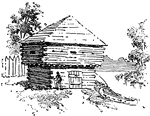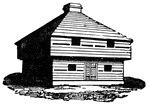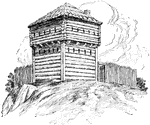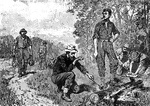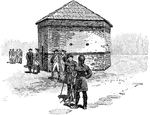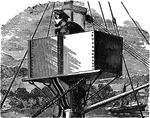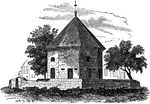The Military Fortification ClipArt gallery offers 78 images of various structures or devices meant to bolster one's own defense while impeding the progress of an opponent. Military fortification can be anything from a castle or tower to a wire fence or chevaux de frise.
Abatis
"Abatis consisting of trees lying parallel to each other with the branches pointing in the general direction…

Balistraria
"One of the names given to those narrow apertures so often seen in the walls of old castles, and through…
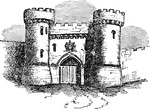
Barbican
"A projecting watchtower, or other advanced work, before the gate of a castle or fortified town. The…
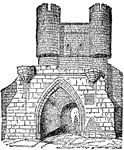
Barbican
A projecting watch tower, or other advanced work, before the gate of a castle or fortified town. The…

Battlement
Battlements are indentations on the top of a parapet or wall, first used in fortifications, and afterwards…

Battlement
Battlements are indentations on the top of a parapet or wall, first used in fortifications, and afterwards…

Battlement
Battlements are indentations on the top of a parapet or wall, first used in fortifications, and afterwards…
Battlement
"An indented parapet, formed by a series of rising parts called cops or merlons, separated by openings…
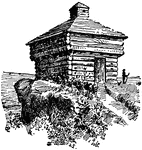
Blockhouse
Blockhouses, built of heavy logs with the second story overhanging the first, were created for defense…
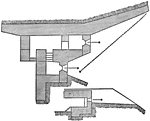
Traditore Battery Bourges Casemate
"Traditore batteries, by hypothesis, fire only to the flank and rear. They are thus always placed, behind…

Castle Garden
An illustration of Castle Garden, known today as Castle Clinton or Fort Clinton. Castle Clinton or Fort…
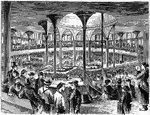
Castle Garden (Interior)
An illustration of the interior of Castle Garden, known today as Castle Clinton or Fort Clinton. Castle…
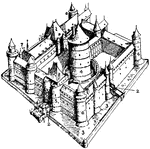
Castle Parts
"Details of a castle: 1. Fortified approach 2. Drawbridge 3. Moat 4. Donjon or keep 5. Towers flanking…

Cavalry obstacle
"A formidable obstacle against cavalry consists of railroad ties planted at intervals of 10 feet with…
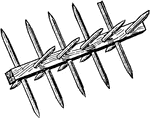
Cheveaux de frise
"They are usually made in sections of manageable length chained together at the ends." — Moss,…

Constantinople
An illustration of the fortification around Constantinople and soldiers firing cannons.
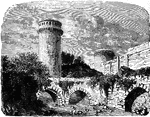
Ruins of Coucy
The ruins of Coucy are what remains of a castle built in about the year 1230 by Enguerrand III, Lord…
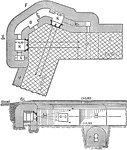
Austrian Fort Counterscarp Casement
"The Austrian counterscarp casement is constructionally simple. Under the counterscarp wall, on the…
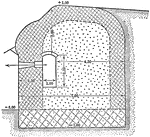
Metz Fort Counterscarp
A diagram illustrating the dimension and construction of the counterscarp at Fort Metz. The surrounding…
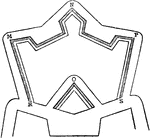
Crown-Work
"Crown-work, in Fortification, is formed to strengthen a weak front, or to occupy ground which might…
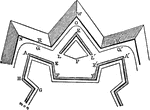
Curtain
"Curtain, in Fortification, is the portion of rampart or wall between two bastions or two gates. In…

Emplectum
"That kind of masonry, much used in ancient fortification-walls, etc. in which the outside surfaces…

Fascine
"A bundle of rods or small sticks of wood bound at both ends and in the middle, used in fortification,…
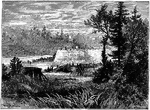
Fort Duquesne
Fort Duquesne (originally called Fort Du Quesne) was a fort established by the French in 1754, at the…

Interior of Fort Garry
Fort Garry, also known as Upper Fort Garry, was a Hudson's Bay Company trading post at the confluence…

Fort George, Old New York City
Fort George, the name of four defensive works connected with warfare in the United States.
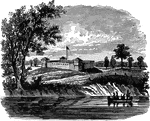
Fort Harrison, on the Wabash
Fort Harrison was an important component of the Confederate defenses of Richmond during the American…

Fort Jefferson
An illustration of Fort Jefferson which is located today in what is Dry Tortugas National Park. Dry…
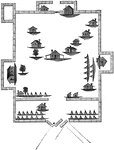
Fort Mims Layout
The Fort Mims massacre occurred on 30 August 1813, when a force of Creeks, belonging to the "Red Sticks"…

Fort Runyon
"Section of Fort Runyon, Va., guarding the road to Alexandria, occupied by the Twenty-first Regiment,…

Fort Taylor
The Fort Zachary Taylor State Historic Site, better known simply as Fort Taylor, (or Fort Zach to locals),…

Fort Wayne
Fort Wayne was established 1839 in Indian Territory by Lt. Col. R.B. Mason of the 1st Dragoons. Named…
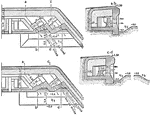
Counterscarp Casement Underground Tunnel Metz Feste Fort
An illustration of a counterscarp casement in Metz Feste Fort. The casement is designed with concrete…

Metz Fort Flanking Organ
A plan showing the flanking organ at Fort Metz. The room is located at or near ground level with rifle…
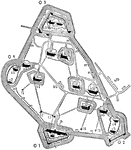
Metz Feste Fort Plan
The plan of the French fort, Metz Feste. The fort was created in 1871 by the German Empire. The fort…
Underground Tunnel Metz Feste Fort
An underground section of the infantry work at Mettz Feste Fort. The underground tunnels leads to the…
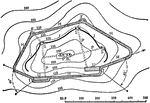
Austrian Design Group Fortification
"On the height 130 is an armoured battery P B, containing four 6 in. howitzers in cupolas, with an observation…

Section of Fortified Wall
"Section of Fortified Wall. (Interior on the left; exterior on the right.) a, a, is the abatis; b, b,…

Forts Pickens and McRae
Fort Pickens is a pentagonal historic United States military fort on Santa Rosa Island in the Pensacola,…
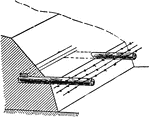
Fraise
"A fraise is a palisade horizontal, or nearly so, projecting from the scarp or counterscarp. A modern…

Chevaux de Frise
Piece of timber travsversed with spikes of iron, or of wood pointed with iron, 5 or 6 feet long, used…

Judith Passes Through the City Gates
"And when they came to the gate of the city, they found Ozias, and the ancients of the city waiting.…
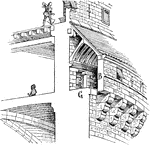
Machicolation
A machicolation is a floor opening between the supporting corbels of a battlement, through which stones…
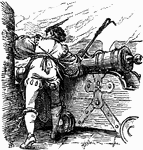
Man Holding Linstock Peers through an Embrasure
A man holding a smoldering slow match on a linstock leans over a cannon to look through an embrasure.

Overhead cover
"In determining the area of overhead cover to be provided, allow 6 sq. ft. per man for occupancy while…
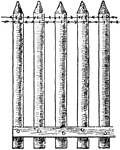
Palisade
"Palisades should be planted to incline slightly to the front. As little earth should be disturbed in…
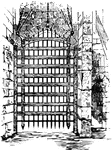
Portcullis
A strong grating of timber or iron, somewhat resembling a harrow, made to slide in vertical grooves…
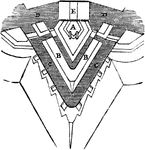
Ravelin
A detached triangular work in fortification, with two embankments which form a projecting angle. In…

Redans
In field fortification, the simplest kind of work employed, consisting of two parapets of earth raised…
